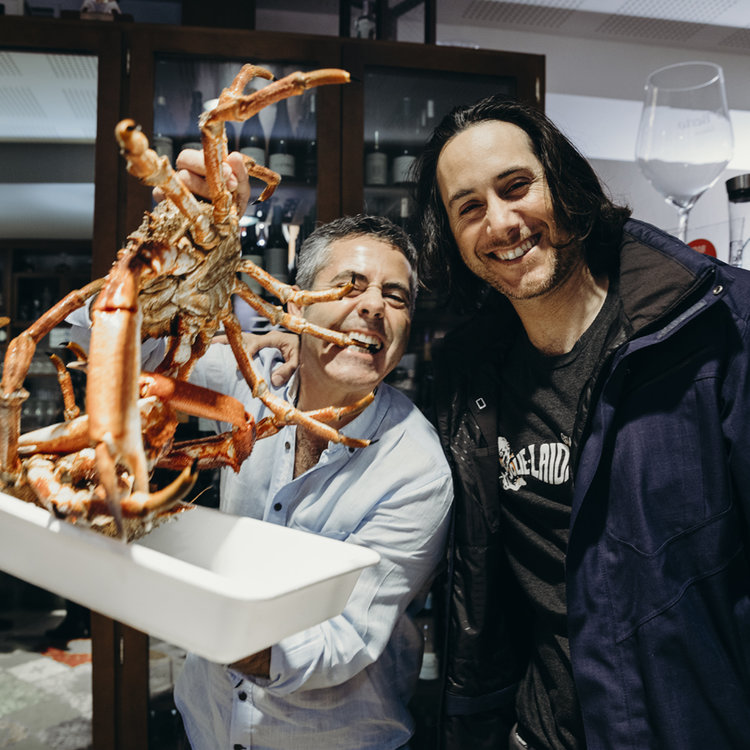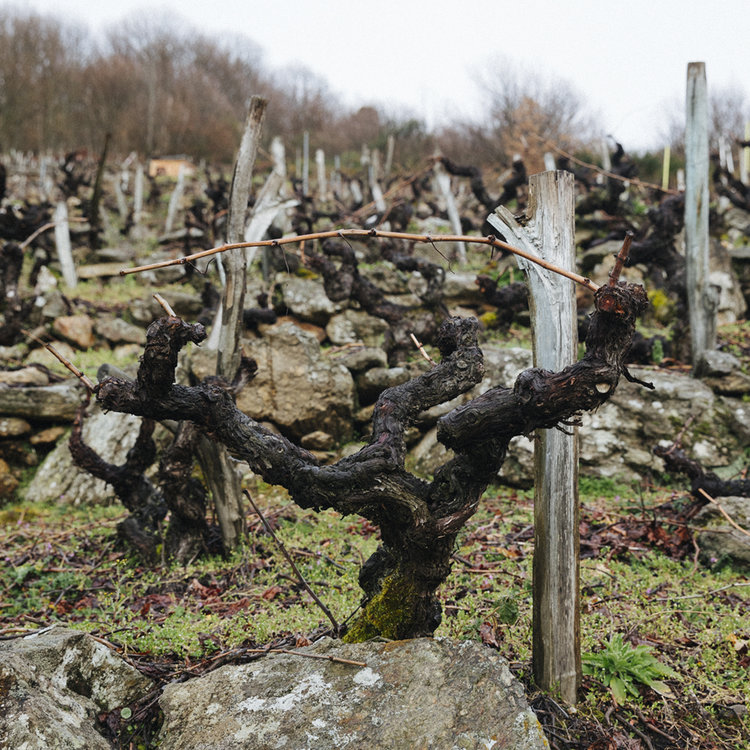back to the future
“There is no place like Galicia...” declares local legend and restaurant owner Berto Domínguez García, while holding up a live spider crab. “It is not like Portugal or other parts of Northern Spain. Arctic currents bring cold, salty waters off our shores. And, many rivers carry sweet water into the ocean. But it is the convergence of the two, and the relentless storms that shake up the strata, melding these flavors, both the sweet and the saline, that makes Galicia special. It is why our seafood is unparalleled.”
As if deified ocean eats weren’t enough, there is another brilliant convergence in Galicia - where treacherous slopes terraced by a vanished empire, lined with all-but-forgotten grapes and vineyards, have been resurrected and restored by a new generation with new ideas. And shaking up the strata, melding the freshest flavors of the ancient and the modern, is a giant storm called Envínate…
BERTO AND HIS SPIDER CRAB. PULPO AND GALICIAN POTATOES FROM A SMALL VILLAGE NEAR THE WINERY.
2017 CLIFFsNOTES
Last year’s offer and blog introduced four friends – Roberto Santana, Alfonso Torrente, Laura Ramos, and José Angél – who met in enology school and formed the brain trust of Envínate in 2005, a relatively cult winery, poised to break on through to the other side. Today the cat is fully out of the bag, as allocations are fought over in nearly every global market. Spanish wine before Envínate never wanted for intensity, but with a countrywide, homogenous diet of heavy extraction, alcohol and new wood, perhaps no winery has sanctified itself so distinctly in the belly of revolution. Their wines are inherently nuanced and transparent, on lighter-weight frames that brim with character and identity. They work exclusively with local grapes, often in field blends, by choice or necessity. As fun as they are dead serious, as down-to-earth as they are intellectual, Envínate wines have a rare bandwidth with consumers and trade alike.
Uniquely manning three regional outposts on mainland Spain, it is undoubtedly the winery’s Ribeira Sacra project (Sacred Bank), in the heart of Galicia, with its rugged extremity and eco-culture trapped in amber, that lives out most intensely what New Vignerons author Luis Gutierrez coins the ‘back to the future’ movement of Spanish wine. Says Luis, “I believe we are finally getting to the essence of place: finding the voice of these regions, the character of the wines without pre-conceived ideas, without trying to imitate others, simply understanding each place and grape for what it is…”
ROBERTO SANTANA AND ALFONSO TORRENTE OF ENVÍNATE SHOWING SOME GUY AROUND GALICIA...
WHAT IS GALICIA?
Spain seems to take a page out of the Italian playbook, for better or worse, clinging fiercely to decentralization. In my six months living in Pays Basque, I never once heard the Basque language spoken on the French side. In Biarritz, taking a class that teaches Basque is more art appreciation than assimilation, whereas a forty-minute drive into Spain uncovers multiple dialects from town to town. So it is in Catalonia, and nonetheless in Galicia.
At just slightly larger than the state of Massachusetts and about 1/3 the population, Galicia is dominated by rural townships and a few, sporadic urban hubs. The largest of which is Vigo, at almost 300,000 people, where Roberto, Alfonso and I were approached by two men, jonesing for a 4am cigarette. After a short exchange with Alfonso, the only native Galician on Team Envínate, the two men waved goodbye and walked away…
ME: “Were they speaking Spanish?”
ROBERTO: ”No. Galego (Galician).”
ME: ”I couldn’t understand a word they said.”
ROBERTO: ”Me neither. What did they say Alfonso?”
ALFONSO: “I could barely understand them. They were from the South.”
Alfonso rarely answers a question directly, a classic Galician trait. He will often answer a question with a question or his signature quip, “It’s possible” or “Could be possible.” Luis Gutierrez wrote an entire article on the subject called “Galicia? It Depends!”. What one could infer as cultural indecision, another could choose to call passive exploration, being open enough to examine all sides of a matter before rendering a verdict. Where the downside of such a mentality can seem wishy washy, the freedom to say ‘no’ slowly and ‘yes’ not too quickly, leaves room for change without being blown about by the wind of fad and fashion.
If it were in the culture to make decisions in a vacuum, it reasons to assume that the families who broke their backs farming these vineyards, with no hope of a better life, would have jumped ship long ago. But the creative insurgence that has now taken hold of the Galican wine trade is as much a matter of character as it is raw material – and nowhere does the lifeblood of such a movement flow so generously than down an ancient river, in a valley like no other…
RIBEIRA SACRA ALBUM COVER WITH SOME ENVINATEROS...
WHAT IS RIBEIRA SACRA?
The heartland of ‘Green Spain’ hugs the Northwest coastline and works its way east where the terrain gets decidedly roughhewn. There are no major cities near Ribeira Sacra. On the outskirts, ag-land for miles with tiny villages; some, charming shrines to medieval times; others, one boarded-up shop away from a ghost town. “It used to be worse…” Alfonso tells me, while driving a potholed, single-lane highway that would give the Road to Hana a run for its money. “In the past, the elderly offered up their homes for free to try to entice the youth to come back and work.”
As the roads twisted and turned, I pondered how and why there has been no foreign investment in Ribeira Sacra, as there have been in other parts of Galicia – mostly notably Rías Baixas on the west coast, where Albariño vineyards are auctioned off at 500,000 to 1 million euro per hectare. As we crossed into the river valley, I got my answer. Who would dare plant a vineyard on these death-defying cliffsides with any hope of economic gain, aside from the people ascribed credit for the undertaking, the Romans…
ME: “How can you possibly make wine here?”
ALFONSO: “It’s possible.”
Wild land…formidable land…cultivated in antiquity, kept alive by monks, and preserved by families over centuries, to be all but forsaken in the last half of the 20th century by the remnants of Civil War and the subsequent Franco regime. What happened in the last 25 years to turn a failing viticultural region with zero commercial interest into the talk of the town amongst wine aficionados globally?
The answer lies with people like Pedro Rodríguez of Adegas Guímaro, a mentor to the Envínate team, and the bridge between an era of wine made for home consumption and a denominated region with serious potential…
WINDY ROADS LEAD TO SPECIAL VINES
THE RISE OF RIBEIRA SACRA THROUGH THE EYES OF GUÍMARO
“25 years ago, a great change began in the area, after the emigration of the local population looking for work…” states Pedro Rodríguez. “My parents, Carmen and Manolo, headed one of a few wineries who created Vinos De la Tierra in 1991, predecessor to the current Denomination of Origin.” Five years later, with the help of enologist Luis Buitrón, Vinos de la Tierra would give way to Ribeira Sacra D.O., and Guímaro would become one of 36 wineries to play house; enduring with it, all the growing pains of a region in prepubescence.
Prior to grander imaginings, Pedro’s family, as was typical in the area, farmed for their subsistence, selling wine from the harvest to local cantinas, while managing (to this day) a modest finca of creatures great and small: pigs, chickens, rabbits and the obligatory vegetable patch. It was Luis Buitrón, who would sign on as winemaker of Adegas Guímaro and encourage the family to estate-bottle. His effect on the quality of the Guímaro wines was immediate. When Pedro was a teenager, Luis took him to other regions of Spain, France, and Italy. “As my grandmother Concha said ‘to learn, you have to see and read’ and that was what Luis did with me.” If for Pedro, Luis Buitrón was the Andre Tchelistcheff of Ribeira Sacra, then proprietor Raúl Perez was the Robert Mondavi. “I think Raúl has been a fundamental person to make the area known to the rest of the world. From the hand of Raúl, I met a group of people and friends, all with the maxim that Galician wines had to have a relevant place in the world.”
Pedro is quick to credit others, especially the palpable connection to his descendants, whose “superhuman effort, without expecting anything in return”, has bled into the current generation of viñadores. “People like Envínate, who understand Ribeira Sacra, with that desire to work, are definitive for the growth of the area. Alfonso is a great person, with a lot of knowledge, that I am lucky enough to learn from every time I see him…”
PEDRO RODRÍGUEZ OF ADEGAS GUÍMARO WITH HIS 99 YEAR-OLD GRANDMOTHER CONCHA, WHO PASSED AWAY LAST YEAR
WHAT IS MENCÍA?
In Ribeira Sacra, there are as many growers as there are acres, roughly 3000, which makes it very complicated to acquire contiguous land. The bulk of these landowners are farming families, not unlike Pedro’s parents, who are now paid top dollar to help wineries like Envínate farm at the gold standard: 100% organic, tailored canopy management, advanced pruning methods, etc. Often the relationship is symbiotic. As Roberto Santana puts it, “The growers work the land in ways that sometimes seem counterintuitive to us at first, but we learn through their generations of experience a deeper sense of the microclimates affecting Mencía here.”
As the dominant variety in Ribeira Sacra, Mencía is a red grape whose identity, much like Syrah, can shapeshift dramatically, depending on where it is grown and how it is produced. The heavyweight examples in Spanish regions like Bierzo, exalting for their mass and volume, run counterpoint to the fresher, more streamline styles in Ribeira Sacra. With poor soils that are naturally well-irrigated and a cooler climate, Ribeira Sacra Mencía sets itself up to be emasculated, with a unique set of conditions that, even outside the winemaker's hand, create more variation of expression: Which of the 5 sub-regions is Mencía grown in? Does the grape reside on the warmer, south-facing slopes of Amandi, leading to a generally richer style? Or does it find itself on the opposite bank in Ribeiras do Sil, struggling to get ripe? Which soil is Mencía grown in? Is the plot moderated by altitude or does it bake further down, near the reflected light of the river? Is the exposition southeast, ripening more slowly through less late afternoon exposure, or do its sugars concentrate quickly due to southwest exposure?
Some wineries attempt to find a consistent thread with the grape by separating out the native varieties that are often co-planted with Mencía – Merenzao (Trousseau), Sousón, Brancellao, Garnacha Tintorera (Alicante Bouschet), Mouratón, etc. Envínate keeps it old-school, electing to co-ferment these grapes that, as Alfonso puts it, “serve as blending components, adding freshness to the low acidity of Mencía.”
Negotiating several fragmented parcels, Alfonso and Roberto walked us down a vertical drop called Camiño Novo, which can drink like a sturdy Northern Rhone Syrah, not far from a more lush, open-knit plot, Seoane. In the quest for “What is Mencía?”, Camiño Novo and Seoane are the only two single vineyards Envínate has bottled to date. With the 2016 vintage, that would change…
MORE GRATUITIOUS SHOTS AT D'BERTO IN O GROVE...
WHAT IS LOUSAS?
For Envínate, however, “What is Mencía?” plays second fiddle to their core doctrine, “What does the vineyard have to say? It’s a simple set up at the winery; cement tanks and neutral barrels. There’s no store-bought yeast or aggressive extractions here…no fining or filtration…or blowtorch-laden sulfur additions. Rack me once, shame on you. Racking me twice… The point being, if Ribeira Sacra Mencía is transparent, Envínate Mencía is buck naked; not for the purposes of shining a light on Mencía, but rather using the grape, just like any other they cultivate, as a portal to place. A little concept the Spanish call 'terruño' (terroir).
On my first trip in May of 2017, I asked Envínate what ‘Lousas’ meant, the Galician word for the local schist soil (broken-up slate). It’s the most obvious word on their Ribeira Sacra wine labels, and if you’ve ever put your nose in a glass, perhaps the most obvious trait in their wines; that is, until I came across a barrel called ‘Rosende’.
ME ”Why does this taste different? Softer, more red fruit…”
ALFONSO ”Do you like?”
ME ”Very much. Have you considered bottling this separately?”
ALFONSO ”Could be possible.”
The Envínate team explained to me that over 85% of the Amandi sub zone is grown on schist, which lends a very specific smokiness and rustic texture. Rosende, by contrast, was ethereal, resembling a silky Burgundy or ultra-classy Fleurie. It was an anomaly in the glass and in the vineyard, where old vine Mencía sits on pure granite.
Somewhere during that day or the next, “could be possible” escaped a veto, and Viticole would be lucky enough to inherit a new Envínate single-vineyard Mencía called ‘Parcela Rosende’. Accompanying this custom bottling, is an exclusive cuvee of ‘Viñas de Aldea’ (vines of the village), a vibrant new expression of Envínate’s overperforming entry-level Mencía. The normal Viñas de Aldea bottling, allocated for distribution, rests in neutral wood, whereas our version, denoted on the label as ‘CV’ (Cuvee Viticole), spent its entirety in cement. What it lacks in the curves that only a wood vessel can furnish, it makes up for in pure electricity…
FINAL THOUGHTS
From my recent trip to Galicia, I jumped on a plane to the Canaries, encouraged. Encouraged, by seafood and potatoes, and by the nature of Ribeira Sacra; to know some places make gentrification untenable. Ribeira Sacra is a pastoral pause button, a fossil with a pulse, whose staggering geography weeds out the carpetbaggers, and whose unique limitations keep the flavors of old and new melding harmoniously. I’m encouraged by the storm of Envínate that rages on, the path this brilliant winery is walking. Their ’17 Mencías, tasted out barrel, will arrive next year in bottle, full of surprises and new stories to tell. Lastly, I’m encouraged by the people, quick to radiate their passion and authenticity, slow to get off the fence. Their loyalty and resilience have been rewarded. May they reach beyond possibility, with the best laid plans of Ribeira Sacra wine, and confidently say, “Yes.”
- Brian McClintic
A special thanks to Viticole operative, Lauren Hamilton, for taking all these lovely photos, except for the shot of Pedro and his grandmother, which was provided by Importer José Pastor; without whom, none of these collaborations would be possible...












